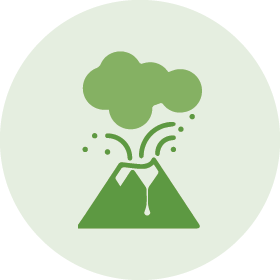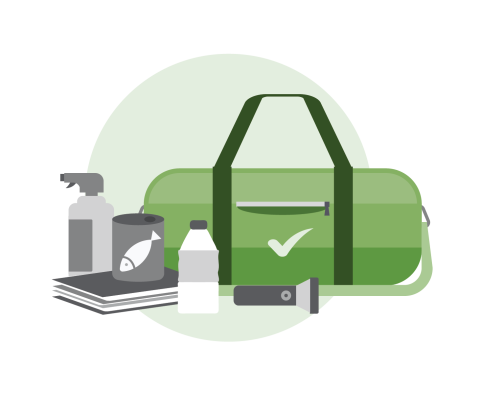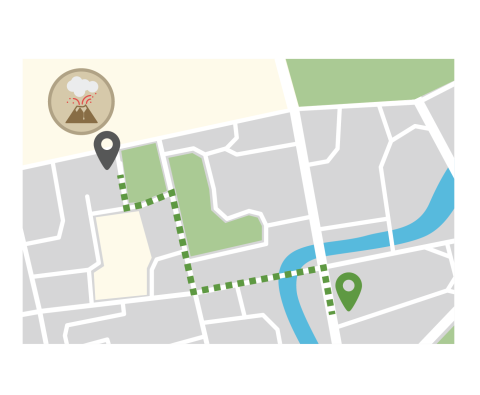Prepare Now
Survive During
Be Safe After
Related Content

If you are a disaster survivor, please visit FEMA.gov for up-to-date information on current disaster declarations. If you have questions about your disaster assistance application, you can call (800) 621-3362, visit disasterassistance.gov or use the FEMA mobile app.
A volcano is an opening in the Earth’s crust that allows molten rock, gases and debris to escape to the surface. During a volcanic eruption, lava and other debris can flow at speeds of up to 100 mph, destroying everything in their path. Volcanic ash can travel hundreds of miles and cause severe health problems.

There are 161 potentially active volcanoes in the United States. Alaska, Hawaii, California, Washington and Oregon have the largest number of active volcanoes, but other states and territories also have active volcanoes.
A volcanic eruption can:
- Contaminate water supplies.
- Damage machinery.
- Reduce visibility through smog and harmful gases that may threaten low-lying areas.
- Make it hard to breathe and irritate the skin, eyes, nose and throat.
IF YOU ARE UNDER A VOLCANO WARNING:
- Listen for emergency information and alerts.
- Follow evacuation or shelter orders. If advised to evacuate, do so early.
- Reduce your ash exposure by doing the following:
- Limit your time outdoors and use a dust mask or cloth mask as a last resort if you must be outside.
- Avoid areas downwind and river valleys downstream of the volcano.
- Take temporary shelter from volcanic ash in the location where you are.
- Cover ventilation openings and seal doors and windows.
- Avoid driving in heavy ash. If you must drive, keep the windows up and do not use the air conditioning system.
- Do not get on your roof to remove ash.
- Stay indoors until authorities say it is safe to go outside.
Prepare NOW

- Know your area’s risk from volcanic eruption.
- Ask local emergency management for evacuation and shelter plans, and for potential means of protection from ash.
- Learn about community warning systems by signing up for a free service called the Volcano Notification Service (VNS) that sends notifications about volcanic activity.
- Get necessary supplies in advance, including nonperishable foods, cleaning supplies and water for several days, in case you have to evacuate immediately or if services are cut off. Keep in mind each person’s specific needs, including medication. Do not forget pets’ needs for medication and food.
- Consult your doctor if you have existing respiratory difficulties.
- Practice a communication and evacuation plan with everyone in your family. Have a plan for pets and livestock.
- Have a shelter-in-place plan if your biggest risk is from ash.
- Keep important documents in a safe place. Create password-protected digital copies.
- Find out what your homeowner’s insurance policy will cover when a volcano erupts.
Survive DURING

- Listen to alerts. The Volcano Notification Service provides up-to-date information about eruptions.
- Follow evacuation orders from local authorities. Evacuate early.
- Avoid areas downwind, and river valleys downstream, of the volcano. Rubble and ash will be carried by wind and gravity.
- Take temporary shelter from volcanic ash in the location where you are, if you have enough supplies. Cover ventilation openings and seal doors and windows.
- If outside, protect yourself from falling ash that can irritate skin and injure breathing passages, eyes and open wounds. Use a well-fitting, certified face mask, such as an N95.
- Avoid driving in heavy ash fall.
Be Safe AFTER

- Listen to authorities to find out when it is safe to return after an eruption. Stay indoors until authorities say it is safe to go outside.
- Send text messages or use social media to reach out to family and friends. Phone systems often are busy after a disaster. Only make emergency calls.
- Avoid driving in heavy ash. Driving will stir up volcanic ash that can clog engines and stall vehicles.
- Avoid contact with ash if you have any breathing problems. People with asthma and/or other lung conditions should take precaution in areas with poor air quality, as it can worsen symptoms.
- Do not get on your roof to remove ash unless you have guidance or training. If you have to remove ash, then be very careful as ash makes surfaces slippery. Be careful not to contribute additional weight to an overloaded roof.
- Wear protective clothing and a mask when cleaning up. Children should not help with cleanup efforts.


